Abstract
Mutational processes of simple sequence repeats (SSRs) in complex genomes are poorly understood. We examined these processes by introducing a two-phase mutation model. In this model, most mutations are single-step changes, but infrequent large jumps in repeat number also occur. We used computer simulations to determine expected values of statistics that reflect frequency distributions of allele size for the two-phase model and two alternatives, the one-step and geometric models. The theoretical expectations for each model were tested by comparison with observed values for 10 SSR loci genotyped in the Sardinian population, whose genetic and demographic histories have been previously reconstructed. The two-phase model provided the best fit to the data for most of these loci in this population. In the analysis we assumed that the loci were neutral and that this population had undergone rapid population growth. Recent observations made for unstable trinucleotide repeats support our suggestion that frequent small changes and rare large changes in repeat number represent two distinct classes of mutation at SSR loci. We genotyped the same 10 loci in Egyptian and sub-Saharan African samples to assess the utility of SSRs for studying the divergence of populations and found that estimates of interpopulation distances from SSRs were similar to those derived from analysis of mitochondrial DNA.
Full text
PDF




Selected References
These references are in PubMed. This may not be the complete list of references from this article.
- Aaltonen L. A., Peltomäki P., Leach F. S., Sistonen P., Pylkkänen L., Mecklin J. P., Järvinen H., Powell S. M., Jen J., Hamilton S. R. Clues to the pathogenesis of familial colorectal cancer. Science. 1993 May 7;260(5109):812–816. doi: 10.1126/science.8484121. [DOI] [PubMed] [Google Scholar]
- Bowcock A. M., Kidd J. R., Mountain J. L., Hebert J. M., Carotenuto L., Kidd K. K., Cavalli-Sforza L. L. Drift, admixture, and selection in human evolution: a study with DNA polymorphisms. Proc Natl Acad Sci U S A. 1991 Feb 1;88(3):839–843. doi: 10.1073/pnas.88.3.839. [DOI] [PMC free article] [PubMed] [Google Scholar]
- Bowcock A., Osborne-Lawrence S., Barnes R., Chakravarti A., Washington S., Dunn C. Microsatellite polymorphism linkage map of human chromosome 13q. Genomics. 1993 Feb;15(2):376–386. doi: 10.1006/geno.1993.1071. [DOI] [PubMed] [Google Scholar]
- Di Rienzo A., Wilson A. C. Branching pattern in the evolutionary tree for human mitochondrial DNA. Proc Natl Acad Sci U S A. 1991 Mar 1;88(5):1597–1601. doi: 10.1073/pnas.88.5.1597. [DOI] [PMC free article] [PubMed] [Google Scholar]
- Hästbacka J., de la Chapelle A., Kaitila I., Sistonen P., Weaver A., Lander E. Linkage disequilibrium mapping in isolated founder populations: diastrophic dysplasia in Finland. Nat Genet. 1992 Nov;2(3):204–211. doi: 10.1038/ng1192-204. [DOI] [PubMed] [Google Scholar]
- Imbert G., Kretz C., Johnson K., Mandel J. L. Origin of the expansion mutation in myotonic dystrophy. Nat Genet. 1993 May;4(1):72–76. doi: 10.1038/ng0593-72. [DOI] [PubMed] [Google Scholar]
- Johnson R. E., Henderson S. T., Petes T. D., Prakash S., Bankmann M., Prakash L. Saccharomyces cerevisiae RAD5-encoded DNA repair protein contains DNA helicase and zinc-binding sequence motifs and affects the stability of simple repetitive sequences in the genome. Mol Cell Biol. 1992 Sep;12(9):3807–3818. doi: 10.1128/mcb.12.9.3807. [DOI] [PMC free article] [PubMed] [Google Scholar]
- Kwiatkowski D. J., Henske E. P., Weimer K., Ozelius L., Gusella J. F., Haines J. Construction of a GT polymorphism map of human 9q. Genomics. 1992 Feb;12(2):229–240. doi: 10.1016/0888-7543(92)90370-8. [DOI] [PubMed] [Google Scholar]
- Lin J., Nei M. Relative efficiencies of the maximum-parsimony and distance-matrix methods of phylogeny construction for restriction data. Mol Biol Evol. 1991 May;8(3):356–365. doi: 10.1093/oxfordjournals.molbev.a040648. [DOI] [PubMed] [Google Scholar]
- Nevanlinna H. R. The Finnish population structure. A genetic and genealogical study. Hereditas. 1972;71(2):195–236. doi: 10.1111/j.1601-5223.1972.tb01021.x. [DOI] [PubMed] [Google Scholar]
- Richards R. I., Sutherland G. R. Dynamic mutations: a new class of mutations causing human disease. Cell. 1992 Sep 4;70(5):709–712. doi: 10.1016/0092-8674(92)90302-s. [DOI] [PubMed] [Google Scholar]
- Rogers A. R., Harpending H. Population growth makes waves in the distribution of pairwise genetic differences. Mol Biol Evol. 1992 May;9(3):552–569. doi: 10.1093/oxfordjournals.molbev.a040727. [DOI] [PubMed] [Google Scholar]
- Shriver M. D., Jin L., Chakraborty R., Boerwinkle E. VNTR allele frequency distributions under the stepwise mutation model: a computer simulation approach. Genetics. 1993 Jul;134(3):983–993. doi: 10.1093/genetics/134.3.983. [DOI] [PMC free article] [PubMed] [Google Scholar]
- Slatkin M., Hudson R. R. Pairwise comparisons of mitochondrial DNA sequences in stable and exponentially growing populations. Genetics. 1991 Oct;129(2):555–562. doi: 10.1093/genetics/129.2.555. [DOI] [PMC free article] [PubMed] [Google Scholar]
- Straub R. E., Speer M. C., Luo Y., Rojas K., Overhauser J., Ott J., Gilliam T. C. A microsatellite genetic linkage map of human chromosome 18. Genomics. 1993 Jan;15(1):48–56. doi: 10.1006/geno.1993.1008. [DOI] [PubMed] [Google Scholar]
- Thibodeau S. N., Bren G., Schaid D. Microsatellite instability in cancer of the proximal colon. Science. 1993 May 7;260(5109):816–819. doi: 10.1126/science.8484122. [DOI] [PubMed] [Google Scholar]
- Valdes A. M., Slatkin M., Freimer N. B. Allele frequencies at microsatellite loci: the stepwise mutation model revisited. Genetics. 1993 Mar;133(3):737–749. doi: 10.1093/genetics/133.3.737. [DOI] [PMC free article] [PubMed] [Google Scholar]
- Vigilant L., Stoneking M., Harpending H., Hawkes K., Wilson A. C. African populations and the evolution of human mitochondrial DNA. Science. 1991 Sep 27;253(5027):1503–1507. doi: 10.1126/science.1840702. [DOI] [PubMed] [Google Scholar]
- Weber J. L. Informativeness of human (dC-dA)n.(dG-dT)n polymorphisms. Genomics. 1990 Aug;7(4):524–530. doi: 10.1016/0888-7543(90)90195-z. [DOI] [PubMed] [Google Scholar]
- Weissenbach J., Gyapay G., Dib C., Vignal A., Morissette J., Millasseau P., Vaysseix G., Lathrop M. A second-generation linkage map of the human genome. Nature. 1992 Oct 29;359(6398):794–801. doi: 10.1038/359794a0. [DOI] [PubMed] [Google Scholar]
- Workman P. L., Mielke J. H., Nevanlinna H. R. The genetic structure of finland. Am J Phys Anthropol. 1976 Mar;44(2):341–367. doi: 10.1002/ajpa.1330440216. [DOI] [PubMed] [Google Scholar]


